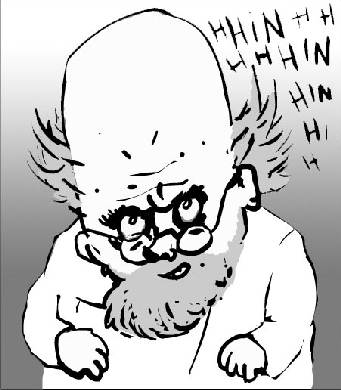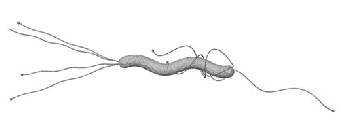This is the press release (slightly edited) which announced this year’s Bent Spoon Winner. Most of the reports used only a small proportion, and included a quote from Ms Fitzsimons saying that the Skeptics could “do whatever they like with their silly bent spoon”.
Supporting the concept of “etheralised Cosmic-Astral influences” as a means of ridding New Zealand of possums has won Jeanette Fitzsimons the 2002 Bent Spoon Award from the New Zealand Skeptics. The annual award spotlights the dangers of gullibility or a lack of critical thought.
“In an area as vital to New Zealand’s ecological preservation as pest control, it is imperative to ensure that publicly funded control techniques are demonstrably effective,” says Skeptics head Vicki Hyde. “That’s why it was so disappointing to see support from the Greens for biodynamic possum peppering as a valid approach to this problem. Our environment needs champions who can separate wishful thinking from reality – if we could wish possums out of this country, they’d be gone overnight!”
Hyde said she was even more disappointed to find out later that Fitzsimons knew of the scientific testing possum peppering had undergone ten years ago. The tests had clearly demonstrated that biodynamic claims of being able to provide a potent repellent were false.
In peppering, the bodies of unwanted organisms are burnt at a certain time in the lunar cycle. The ashy remains are then watered down to produce a spray said to repel, some claim sterilise, the pest concerned. The dilution is to the point where no actual substance remains other than water, which is where the “vital life-force” and “planetary influences” of biodynamics’ “spiritual science” are said to take over.
A decade ago, the Forest Research Institute was the first organisation in the world to test these claims scientifically and in “a reasonably rigorous fashion”, according to Hyde who studied them at the time. They involved the Biodynamic Farming & Gardening Association, a biodynamic farmer and a homeopathic company, and proponents predicted that the “possums would not go near the treated areas and they would probably be desperate to get out of the cages”. In fact, the possums showed no discernible reaction to the spray.
Hyde says that the Skeptics support the examination of such proposals in case there is some undiscovered, effective strategy that has not been identified, but says that “peppering has already been closely examined and found wanting.”
Hyde is concerned that ten years on, peppering is still being proposed as a means of pest control, in Auckland with regard to painted apple moth and with the Green support for its use against possums.
“We’d hate to see public time and money spent on this when it has the potential to delay or dilute real, demonstrably effective approaches to such crucial areas as pest control. We can’t afford to do that when we’ve got possums chomping through tonnes of native forest every night and killing endangered hatchlings.”
The Skeptics conference, which opened in Christchurch on Friday the 13th of September included a presentation on the biosecurity hazards associated with this form of alternative agriculture.
The conference also saw the presentation of the society’s Bravo Awards, honouring intelligent reporting and critical thinking.
“We were pleased to see Mark Chrysell of the Assignment team actually walk into the forests allegedly silenced by 1080-based pest control and listen to the sounds of our recovering birdlife. His ‘Hello Possums’ documentary was a well-balanced piece which allowed both sides of the 1080 debate a chance to make their points.”
The Skeptics have also applauded:
Lynley Hood, author of “A City Possessed”
“There is no question that sexual abuse of children occurs, but the Christchurch Civic Creche case has always raised big question marks for those familiar with the social context and the similar cases overseas which preceded it. Lynley’s work has served to help clarify what makes this case so different from the unquestioned abuse cases that are found all-too-often in our court pages.”
Noel O’Hare, Listener Health columnist
O’Hare has been a previous Bravo Award winner, and his work cited in this year’s award includes the columns Silent Spring Fever (January 19, 2002) and Get Your Snake Oil here (August 17, 2002)
“Health columnists can be very influential, so it is good to see that Noel continues to present a level-headed view in this important area.”
Diana Wichtel, New Zealand Herald
Wichtel was nominated for her hard-hitting article A Monstrous, Lethal Arrogance (June 15), which described the death of Caleb Moorhead as the result of a “severe intelligence deficiency” on the part of his parents. Moorhead was the child who died as a result of his parents’ extreme form of dietary restrictions followed as part of their religious beliefs.
“We were interested to see her comment ‘No beliefs, religious or other, should be tolerated if they deny any child adequate medical care’, and wish this statement had been made clearly through the media some years earlier with regard to the Liam Williams-Holloway case and others.”
Joe Bennett, Press columnist
“We all need a little humour in our lives, and Joe Bennett’s pieces have often taken a good-natured look at the foibles of Mankind’s beliefs in odd notions. He can be scathing and make you smile at the same time, which is an admirable characteristic.”
Biodynamic Background
In her response to the award, Ms Fitzsimons said that the tests by FRI had been poorly designed and proven nothing. She also claimed that she had not advocated peppering, although the original television item showed her saying that she thought it was worth testing (which suggested that she did not know that it had already been tested).
Here are copies of the emails exchanged at the time of the broadcast earlier this year.
Vicki Hyde to Jeanette Fitzsimons, 29 March 2002
Greetings,
I was startled by your comment on television last night re the lack of scientific testing of possum peppering and how this might be a good approach to possum control for New Zealand — I guess you are not aware that possum peppering has been tested independently and scientifically in the past and found not to work.
So in the interests of ensuring that you have some background in this area — a vital one for New Zealand’s ecology after all — I thought I’d drop you a line so that next time it comes up (as it does every couple of years), you might have a better understanding of the issue.
The Forest Research Institute back in 1991 tested this thoroughly when this approach was proposed for possum control on Rangitoto Island. If I recall correctly, they were given around $40,000 to undertake a full set of tests courtesy of the Animal Health Board.
The tests involved the assistance of the Biodynamic Farming and Gardening Association, but clearly demonstrated that the peppering solution was no more effective than using plain water. In my role as editor of the NZ Science Monthly at the time, I actually critiqued the FRI methodology, and they were honest and careful enough to repeat their tests more rigorously, with the same non-results, sadly.
I say sadly, because possums are one of the most dangerous threats to our native flora and fauna (humanity being the greatest, of course). It would have been wonderful to have had an effective, safe, cheap means of possum removal or sterilisation, but this was not the case with peppering.
I appreciate that there are many people who claim to have seen peppering work, but their “tests” usually end up being very informal ones, often anecdotal (a friend of a friend said it worked on his property). As far as I am aware, there hasn’t been anything in any peer-reviewed literature since Eason and Hickling did their work for FRI.
There are many people with vested interests in peppering, whether emotional (as is the case of many of the well-intentioned people using it) or commercial (as with companies supplying biodynamic solutions and services). And it sounds like an easy, no-risk fix, which is why I guess it appeals.
It is all too easy to find people who can make a claim, often sincerely, but that doesn’t make them right. After all, millions of people once believed that the Earth was flat! That’s why it is so important to do the tests in as independent and objective a fashion as possible and, ideally, independently repeating “successes” so that we don’t end up fooled by our own errors and illusions. This is the foundation of science, and it serves as a form of consumer protection for the many ideas that are mooted.
I was very pleased to see you mention the importance of doing this but, as noted, surprised that you weren’t aware of the fact that it has been done once already at least. Certainly one might wish for more testing to be absolutely, positively sure, but I’m sure you appreciate the difficulty of getting public funds to repeat results which show that something doesn’t work! And that’s quite apart from the issue of what sort of mechanism would permit the highly diluted ash of an animal scaring or sterilising another animal…
Because of my science connections, not least with heading the Skeptics, I served on Landcare Research’s Possum Bioethics Committee for eight years until it was disbanded. I served alongside representatives from Forest and Bird, the RNZSPCA, tangata whenua, Federated Farmers (and indeed argued strongly for the involvement of environmental groups with the committee).
We all agreed that we wanted to get rid of possums as quickly and effectively (and humanely) as we could. We all recognised that there are very few easy answers in life, particularly when dealing with the full ramifications of pest control in a complex ecological system. That said, we do hold out hopes for some of the approaches being developed, though I suspect that debate will continue as to the right way to go about this.
But the important thing we have to concentrate on is that the possum control approach we choose is one which works – not one we believe will help. Environmental funding in this country is, regrettably, woefully underfunded, so it is vital that we spend those funds on approaches which work and which can be demonstrated to work.
Possum peppering has been demonstrated NOT to work, not at all – about the only way you could deter possums with it is to have a vast amount of the peppering solution (ie water) in a firehose and spray individual possums until they fall off a cliff into the sea! (Not that I am suggesting that that is an effective – or humane – way of dealing with 70 million of the pests… 🙂
It is important that we look at the real merits of each case – and peppering doesn’t have any. 1080 has some merits, with obvious concerns which need addressing, but I think on the whole it is better than doing nothing. I fervently hope the new biologically-based approaches will be much better, though there will be issues to address regarding the involvement of genetic manipulation.
I do hope that you appreciate that any comments re peppering were certainly not off-the-cuff or knee-jerk ones made by those with no understanding of the situation or appreciation of the urgent need to protect our flora and fauna from the ravages of this, and other, introduced pests. As you’d know, it can be hard, in many cases, to get the full details across in the sound-bites which media afford us….
Best regards,
Vicki Hyde
Jeanette Fitzsimons to Vicki Hyde, 2 April 2002
Dear Vicki
Thank you for your message. I am, of course, well aware of the FRI trials. They treated it as a poison and placed it on plastic out of contact with the soil. I’m still puzzled as to why the BD Association went along with this.
When testing the efficacy of something where you don’t understand the mechanism you are working with it is easy to set up a trial that will have no effect. I don’t blame FRI for this – they had little to go on. Most chemical poisons would not work if applied in the wrong way or at the wrong time or in the wrong dilution.
However, it was not in any way a conclusive test. Also, the monitoring was very short term. The fact is a number of farmers are using the technique for weeds, insects and possums and finding some effect. Practising farmers don’t keep doing things that don’t work. The issue is rather just what mechanism are we working with here and how can it be best enhanced and can it be used on a large scale.
The $40,000 spent by FRI is tiny compared with nine years on GE carrots and still nothing to show for it.
What I would like to see is a trial where those who have worked with the method for a decade or more design the experiment and sceptical scientists monitor the results – but over a long enough time to show delayed effects. Not a lot to ask.
If we refused to use technologies where we don’t understand exactly what is going on we’d still be without electricity and anaesthetics – or so my physicist and chemist friends tell me.
Graham Hickling to Jeanette Fitzsimons, cc Vicki Hyde 15 April 2002
Dear Jeanette
I am one of the researchers who undertook the FRI “Possum peppering” trial in the early ’90s. Vicki Hyde and I have been discussing the media coverage of this topic and she has now passed on to me your recent email. I would like to respond briefly to several of the points you made to her.
1) I am, of course, well aware of the FRI trials. They treated it as a poison and placed it on plastic out of contact with the soil.
We were testing for repellent effects. Toxicity effects weren’t being claimed by the biodynamic growers – they believed the “pepper” would be an effective repellent.
There were three trials undertaken – the third of which ran for several weeks under field conditions. In the third trial the pepper was applied directly to the ground, with NO contact with plastic.
The other two trials did involve plastic. As you will be aware, the trials were designed in consultation with senior members of the Biodynamic Farming and Gardening Association. They never expressed any concern with that aspect of the study when it was being designed. Nor was this issue ever mentioned by those who were advocating that Doc use the technique as an alternative to poison on Rangitoto Island. This highlights the difficulty of designing a trial that addresses all possible future criticisms of it.
[extra comment from Vicki: the painted apple moth biodynamic proponents wanted to put their preparation inside a PVC pipe so it could radiate its repelling energy field — lots of plastic there!]
2) The fact is a number of farmers are using the technique for weeds, insects and possums and finding some effect.
They certainly believe it has an effect. Unfortunately, I am not aware of anyone that has yet demonstrated the effect in a manner that would be robust to the same type of scepticism that you are directing at our trial. I would be as happy as anyone to see such a demonstration.
3) The $40,000 spent by FRI is tiny …what I would like to see is a trial where those who have worked with the method for a decade or more design the experiment and sceptical scientists monitor the results – but over a long enough time to show delayed effects. Not a lot to ask.
A longer term trial would certainly address some of the criticisms of our trial, but would inevitably be expensive. Our pilot trial was funded by the levies that cattle farmers pay when their cattle are sold (ie, Animal Health Board funding). If there had been ANY evidence of a peppering effect, our recommendation would have been to investigate further with longer, more extensive trials.
However, since we found NO sign of an effect we felt it inappropriate to recommend that the taxpayer or farming community pay for further expensive work. Rather, we felt a more appropriate course of action would be for the proponents of peppering to fund further trial work to demonstrate the effect(s) they claim for the method.
4) If we refused to use technologies where we don’t understand exactly what is going on we’d still be without electricity and anaesthetics – or so my physicist and chemist friends tell me.
This issue of “what’s the mechanism?” is very much a red herring. If the pepper repels possums – or sterilises them, or whatever – then that EFFECT should be readily measurable. (If the effect is only a subtle one then it won’t be of much practical use for pest control…).
If someone runs a valid trial that produces convincing evidence for a useful peppering effect then I can assure you that this will spur researchers on to try and figure out the underlying mechanism. (This is what happened with GE research…puzzling effects were evident from early trials, which prompted many subsequent research projects to gradually unravel and develop an understanding of the genetic mechanisms).
Unfortunately, researchers and funding agencies have NOT yet seen convincing evidence that a peppering effect exists. It is therefore unsurprising that they are not currently putting any further effort or funds into researching the mechanisms of how it might work.
If I can be of any assistance to you on this or related matters at a later date please contact me – pest management in New Zealand is a vexing issue that we must all struggle with and I certainly agree that wherever possible we must seek to reduce the application of toxins in the fight against possums.
Yours sincerely,
Graham Hickling
Senior lecturer in Wildlife Management, Lincoln University
Green Around the Gills
Within 12 minutes of the press release being sent out to the email alert list, Vicki Hyde had a response from a senior office-holder in the Green Party expressing concern about the award, but acknowledging that it was deserved! These are his comments on how he saw the debate from within the Green Party.
The subject of possum peppering came up on the Green Party internet “Green Views” list. I was critical of the speech made by leader Jeanette Fitzsimons to the Institute of Engineers suggesting that “alternative forms” of dealing with possums were available, including “possum peppering” which needed more testing to prove its effectiveness.
I stated that there had been testing of this “remedy” some time ago, but it had been found to be ineffective and had to be regarded as more a belief than a science. I was attacked by Meriel Watts (Soil and Health) who demanded that I produce the research results or tell her where she could find them. I was unable to, but later understand that Jeanette Fitzsimons knew what they were all about all along, and had been in contact with Vicki Hyde about them.
On at least two occasions I asked Jeanette (through the list) to respond to the criticisms about her speech and/or provide more information to ordinary members of the Green Party through the list. There was no response whatsoever from Jeanette Fitzsimons. Some members posted details of very critical newspaper editorials – one in the Auckland Herald which was critical about the “occult” view of people in the Green Party (as represented by their apparent belief in possum peppering). They made a comparison to Waikato water having magical Maori qualities and that it shouldn’t be piped to Auckland, in the same breath as the apparent green belief in possum peppering. Another editorial was in, I think, a New Plymouth paper.
Another member gave details about a website that paraded new age stuff, even astrology, and offered to take people’s possum skins, incinerate them, and post the ashes back to them for a fee of $350. Also the site revealed that the theory of possum peppering was devised by Rudolph Steiner in 1923 but that it had never entered the practical realm as a remedy in subsequent years, because people found that it didn’t work.
Some members became quite passionate about defending the practice and in the event, tempers flared and a couple of apologies were issued. Certainly, there was a large amount of polarisation on this issue.
My opinion was, having talked to a number of other people about it, that “belief” in this sort of occult practice was not confined to the Green Party but had adherents in equal proportion to sensible people in most of the political parties. Who can forget the United Future MP who said that Mother Mary protected Wellington churches from earthquake damage and deaths and that they didn’t need insuring?
I had a number of supporters in my stance against possum peppering on the Green Views list, but my main disappointment lay with Jeanette Fitzsimons herself, who found herself unable or unwilling to address the criticism of members over this matter. Also I was disappointed at the reaction of Meriel Watts whose refusal to debate the issue resulted in the inference of her support for possum peppering1, and cast some doubt at the veracity of the worthy things she stands for – including alternatives to pesticide and herbicide treatment, and her worthy support for organic farming (which does have a sound scientific basis), and her anti GE/GM stance.
I have to say that there are many Green Party members who are respected scientists in their own right and do not have any truck with new age stuff and possum peppering in particular.
1Meriel Watts was involved in the proposal to use peppering to eradicate the painted apple moth in Auckland, so her support of peppering does not need to be inferred…





